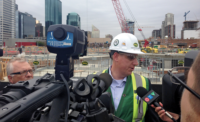As the managing director of the American Institute of Architect's Contract Documents program, Ken Cobleigh was responsible for the once-per-decade review-and-rewriting process that culminated in the release in April 2017 of the updated A201—the General Conditions for the Contract for Construction—and other related contract documents. The changes reflect in many ways the fast-changing methods of design and construction, including contract exhibits related to building-information modeling, sustainability and insurance. Cobleigh, who studied law at the University of Maryland, was a construction litigation attorney before joining AIA 11 years ago. He spoke with Deputy Editor Richard Korman about the new insurance exhibit and other matters related to the new AIA standard form agreements and risk allocation.
ENR: The pace of change in architectural practice and construction seems to have picked up.
Cobleigh: This release was more evolutionary than revolutionary. It brought forward a lot of documents and concepts we developed in the past 10 years, and in this edition we wanted to wrap them all together. The insurance exhibit is the biggest change, but there's much new content now on sustainability and BIM.
Why was a special insurance exhibit needed?
AIA documents, and in particular Article 11 of A201, always addressed property coverage and other insurance requirements. But over the last 10 to 20 years, the insurance industry has evolved, and now there is a plethora of different coverages to meet different needs. So rather than try and bundle this wide variety of coverages in Article 11, or in the main body of the owner-contractor agreements, we felt that the best way to go with insurance affecting the owner-contractor relationship was to create an exhibit that went into significant detail on insurance and bonds.
In the insurance exhibit, there is a list of the coverage add-ons for builders' risk policies, such as civil-authority insurance and ordinance or law insurance.
Beyond contractors' general liability and workers' compensation, we wanted to prompt parties to consider different property coverages or extensions that may be beneficial.
And highlighting those coverage options is meant to prevent delay or liability claims?
One of the key principles we follow is to appropriately allocate risk, using good allocation tools. Insuring against losses is one of the keys to helping avoid claims or litigation.
An owner can fill out and give the exhibit to the contractor, saying, "This is what is required. Do you see problems? What's this cost?" They can craft coverage and send it to their insurance counsel.
Separate from the insurance exhibit, what about the sensitive issue of who A201 selects as the Initial Decision Maker (IDM) in disputes?
Until 2007, the architect was the IDM—no questions asked. In 2007, A201 gave the owner and contractor the ability to name somebody else. The way it's written now, the owner and contractor can appoint some other third party as IDM, and they become responsible for reviewing claims and making initial decisions. Then the parties have the ability to trigger mediation and dispute resolution.
The whole purpose of the IDM is to keep the project going, so that even if there is a claim, the parties have to perform in accordance with findings of the IDM but can't stop performing over the dispute. Sometimes the contractor has to keep performing even though it thinks the work involves a change in the scope or design. Sometimes the owner has to pay even if it doesn't think it's a valid claim. So it cuts both ways and keeps the project moving and keeps the owner and contractor tied to their responsibilities. That's the role.
And what about the change in how notification of the end of insurance coverage is handled?
For a long time, AIA documents said certificates of insurance would provide that the owner would be given 30 days notice pending any lapse in coverage. If coverage is up for renewal or there is an end of coverage, the owner would be given notice by broker or carrier.
After the AIA's 2007 release, the issue came to a head, and insurers said, "Our policies don't say we have to do it, and if you want some notice, it's not our obligation to figure out who the owners are and tell them something happened and the policy is not renewed." That happened in the 2008 and 2009 timeframe after we published the 2007 release.
Owners bank on certain levels of insurance by contractors, folks bank on builders' risk, so it is really important that they know and have confidence that coverage remains in place. So if insurers are not notifying, we thought it was important to say the parties have a short window to notify each other and to allow them to stop the project until the lapse is cured. That will reduce the possibility of a bad event without coverage.
Other associations publish standard form agreements. What is AIA's approach or philosophy?
We have a long history of developing documents that we believe are fair and balanced and have over 125 years of experience in the industry. That more than suggests they are fair and balanced and a good starting point. We do believe they set industry standards for terms and conditions and how the industry ought to behave on projects.





Post a comment to this article
Report Abusive Comment